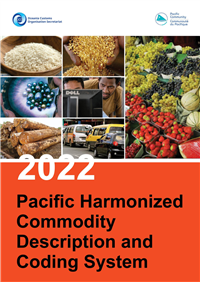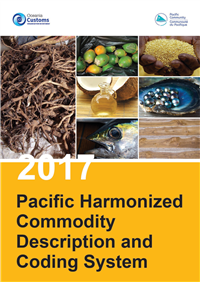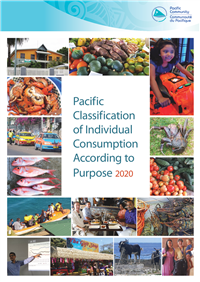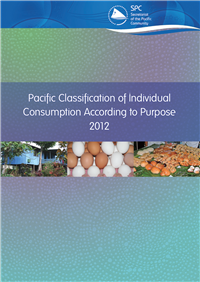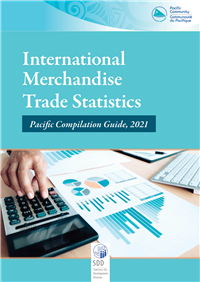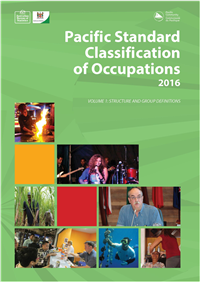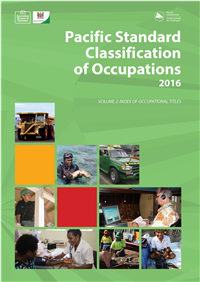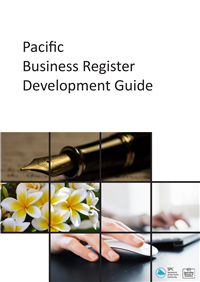Pacific Harmonized Commodity Description and Coding System 2022 (PACHS22)
The Pacific Harmonized Commodity Description and Coding System 2022 (PACHS22) is a multipurpose goods nomenclature that forms the basis for Customs Tariffs and International Merchandise Trade Statistics and has been derived from the World Customs Organisation’s (WCO's) HS22. PACHS22 that will be applicable to all goods traded from 2022 to 2026 will enable all SPC and OCO member countries that are at different levels of implementing WCOs HS22 adopt a common benchmark and better reflect goods exported and imported by the Pacific region using a standardized system of names and codes.
PACHS22 can be downloaded using this link.
Pacific Harmonized Commodity Description and Coding System 2017 (PACHS17)
The PACHS17 forms the basis for Customs Tariffs and International Merchandise Trade Statistics and has been derived from the World Customs Organisation’s (WCO's) HS. PACHS17 enables all SPC and OCO member countries that are at different levels of implementing WCOs HS17 adopt a common benchmark and better reflect goods exported and imported by the Pacific region using a standardized system of names and codes.
Download PACHS17 6MB
Pacific Classification of Individual Consumption According to Purpose (PACCOICOP) 2020
The Pacific Classification of Individual Consumption According to Purpose 2020 (PACCOICOP 2020) is a regional classification of goods and services purchased by individuals and households in the Pacific Island countries and territories. PACCOICOP 2020 has many uses, of which the major ones are:
- constructing/reweighting the Consumer Price Index (CPI);
- further processing the data to derive the final consumption expenditure; and
- conducting poverty studies.
PACCOICOP 2020 is a tool that will enable comparison of household expenditure data regionally and internationally.
Download PACCOICOP 2020 5MB
Pacific Classification of Individual Consumption According to Purpose (PACCOICOP) 2012
PACCOICOP 2012 has been derived from the United Nations (UN) Classification of Individual Consumption According to Purpose (COICOP) which is a classification of expenditure according to purpose. Necessary modifications have been made to PACCOICOP 2012 to meet regional requirements and this has been done without disturbing the framework of the UN COICOP so that international comparisons can be made. This is the first regional classification for PICTs and shows household consumption on food, clothing, housing, health and education, all of which are important indicators of national welfare.
Download PACCOICOP_2012 2MB
International Merchandise Trade Statistics Pacific Compilation Guide 2021
The International Merchandise Trade Statistics Pacific Compilation Guide 2021 aims to address challenges faced by the National Statistics Offices of the Pacific Island countries and territories to produce reliable and timely trade statistics needed by the various users, most importantly the government. The guide not only recommends the use of UNs recommended best practice, but it also outlines the steps necessary to produce International Merchandise Trade Statistics; that is from the collection of the data to the dissemination of information.
Read the IMTS Pacific Compilation Guide, 2021.
Pacific Standard Classification of Occupations (PACSCO) 2016
The PACSCO 2016 is a regional classification of occupations and jobs common in Pacific Islands Countries and Territories. It is the first regional classification of occupations and has been developed to better reflect the world of work in the Pacific region, whilst at the same time facilitate comparison of occupation statistics regionally and internationally. Derived from the International Standard Classification of Occupations 2008, it includes a number of occupations that are unique but significant to the Pacific region.
A major use of PACSCO 2016 will be for classifying occupation information collected in population censuses and other surveys. It can also be used for designing training programmes to match skill requirements in the labour market.
The classification is contained in two volumes:
Volume 1 presents the structure and definitions of all groups in the PACSCO 2016. Volume 2 contains the index of occupational titles.
Pacific Standard Industrial Classification (PACSIC) 2014
The PACSIC 2014 is a regional classification of all productive activities undertaken in the Pacific Island Countries and Territories (PICTs). It has been derived from the United Nations (UN) International Standard Industrial Classification of All Economic Activities (ISIC) Revision 4.
Its main purpose is to provide PICTs a coherent and consistent classification structure of activity categories based on a set of internationally agreed concepts, definitions, principles and classification for use in the collection and reporting of statistics according to kind of economic activity in the fields of economic and social statistics.
Download PACSIC_20141.75MB
Pacific Business Register Development Guide 2014
This guide is jointly produced by the Pacific Community (SPC) and the Australian Bureau of Statistics (ABS) as part of their effort to provide leadership for statistical development in Pacific Island countries and territories (PICTs). It is a broad guide to assist the development and improvement of business registers in national statistical offices (NSOs) in PICTs, to ensure that:
- development progresses according to global best practice; and
- development occurs consistently and harmoniously within the Pacific region to allow better statistical comparability across borders and future cooperation between NSOs in the region.
